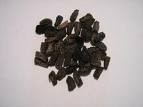DEVIL’S CLAW, HARPAGOPHYTUM PROCUMBENS
Devil’s Claw is a native to the Kalahari Desert so stretches through Namibia, Botswana and South Africa, and also grows in Madagascar. The San tribe of the Kalahari is believed to have been the first to recognize the medicinal properties of Devil’s Claw which is still being investigated by medical researchers in the West because of its analgesic (pain-killing) and anti-inflammatory properties.
 Harpago means grappling hook or iron, in Greek, and phytum is plant, procumbens, meaning prostrate describes the way it spreads across the ground as it is a vine-like plant with red, purple or pink trumpet-shaped flowers. These give way to spiny fruits which then produce dark-brown or black seeds. However it is the thick, fleshy secondary roots which have been subject to investigation which is still ongoing. It is related to the little sesame seed.
Harpago means grappling hook or iron, in Greek, and phytum is plant, procumbens, meaning prostrate describes the way it spreads across the ground as it is a vine-like plant with red, purple or pink trumpet-shaped flowers. These give way to spiny fruits which then produce dark-brown or black seeds. However it is the thick, fleshy secondary roots which have been subject to investigation which is still ongoing. It is related to the little sesame seed. Traditionally in African medicine Devil’s Claw has been used as a virtual cure all for such diverse diseases as fevers, malaria, menstrual cramps, the pains of childbirth, TB and other infectious diseases, hypertension, gout, liver disorders, peptic ulcers and other stomach disorders, to stimulate the appetite, lower cholesterol levels, purify the blood as well as for the relief of pain associated with arthritis and rheumatism. In ointments it is used externally to heal wounds, get rid of ulcers, boils and rashes and it is reportedly also used for insect bites.
 The German Commission E has approved its use for dyspepsia, stimulating appetite and resting degenerative disorders of the muscoskeleton. It is an active ingredient of ¾ of prescriptions for arthritis and rheumatism and has been over-harvested to the point where it is under threat of extinction. In Namibia there is a sustainable project which was established to harvest the root set up in 1999 and seeds have been deposited in the Kew Gardens Millennium Seed Bank, so that it won’t actually become extinct because of irresponsible harvesting. Unfortunately it, like the Himalayan Yew has been discovered by the West and so the market for Devil’s Claw roots has exploded.
The German Commission E has approved its use for dyspepsia, stimulating appetite and resting degenerative disorders of the muscoskeleton. It is an active ingredient of ¾ of prescriptions for arthritis and rheumatism and has been over-harvested to the point where it is under threat of extinction. In Namibia there is a sustainable project which was established to harvest the root set up in 1999 and seeds have been deposited in the Kew Gardens Millennium Seed Bank, so that it won’t actually become extinct because of irresponsible harvesting. Unfortunately it, like the Himalayan Yew has been discovered by the West and so the market for Devil’s Claw roots has exploded. Because of its anti-inflammatory properties it is being investigated as a possible alternative to the nonsteroidal anti-inflammatory drugs (NSAIDs) which have received such bad press because of their adverse side effects. The active ingredients of the root believed to be responsible for its analgesic and anti-inflammatory properties are the glycosides harpagoside and acteoside. Medical research has shown that inflammation is the key pathological factor in such common diseases as Alzheimer’s, osteoporosis, cardio-vascular diseases, diabetes, dementia and other neurodegenerative diseases, which is why such extensive research is being done on Devil’s Claw. However, although researchers have had good results in vitro and in vivo there is much still to be done before they will say whether or not drugs which contain Devil’s Claw can help with the above-mentioned diseases.
 |
| Devil's claw Seeds |
It can be brewed into a tisane and drunk to stimulate the appetite and aid digestion, and this can also be applied to skin problems.
Hopefully our increasing demand for Devil’s Claw will not lead to its extinction from its natural habitat.


